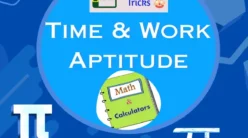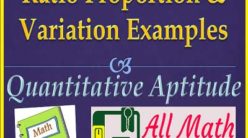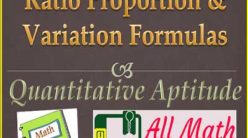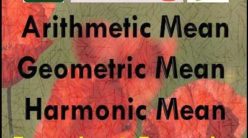Easy tricks to solve average problems with solutions for competitive exams
In Exercise – I given basic concepts of average chapter with formulas like Weighted Average, Average age /weight, Average Speed.. etc. In Exercise – II Covered average of numbers formulas like average of natural, even, odd, squares of natural, squares of even, cubes of even numbers … etc. Now in this Exercise given remaining formulas with some practice average problems to cover all formulas in Exercise I & II.
Average formulas:
1. If distance “P” is covered with speed ” X”, distance “Q” is covered with speed ” Y”, “R” is covered with speed ” Z”, then for whole journey
Average speed =
2. If a person covers “P” part of his total distance with speed of “X” , Q parts of total distance with speed of “Y and “R” parts of total distance with speed of “Z” then
Average speed =
Practice sums on average chapter:
Example – 1 : The average of 52 numbers is 45. if two numbers, namely, 55 & 45 are discarded from the set of number, then find average of the remaining numbers.
Solution: The sum of remaining 50 number ( i. e 52 – 2 )
52 x 45 – 45 – 55 = 2340 – 100 = 2240
The average of remaining numbers = 2240 / 50 = 44.8
Example – 2 : Find the average of the first 97 natural numbers.
Solution: Average of first ” n” natural numbers =
According the formula (97 + 1) / 2 = 49
Example – 3 : Fina the average of first ten whole numbers.
Solution: Average of first ” n” whole numbers =
According to above formula = (10- 1) / 2 = 4.5.
Example – 4: Fins the average of first 10 multiples of 12.
Solution: Average of first “n “multiple of ” m” =
12 ( 10+1) / 2 = 6 x 11 = 66.
Example – 5 : The average of 5 consecutive numbers is 18. Then find height of these numbers.
Solution: Here the number would from an Arithmetic Progression(AP) with common difference” 1″ and the middle term ( 3rd term) as 18.
Thus, the number would be 16, 17, 18, 19 & 20.
The highest of these numbers would be 20.
Example- 6: The average of ten numbers is 15. If each number is multiplied by 12, then find the average of the new set of numbers.
Solution: When we multiply each number by ” X “, the average would also get multiplied by “X”.
Hence the average of new set of numbers = 15 x 12 = 180.
Example – 7: In a certain school, there are 60 boys of age 12 each, 40 of age 13 each, 50 of age 14 each and 50 of age 15 each. Find the average age (in years) of the students of the school.
Solution: Here using Weighted Average formula
=
= 2690 / 200 = 13.45
Example – 8: The average of 25 innings of a batsman is 40 and another 30 innings is 50. What is the average of all the innings?
Solution: Here using Weighted Average formula
= [ (25 x 40) + (30 x 50) ] / (25 + 30)
= (1000 + 1500) / 55 = 2500 / 55 = 45.45
Example – 9: The average of a batsman after 25 innings was 62 runs per innings. If after the 26th inning his average increased by 1 run, then what was his score in the 26th inning?
Solution: By normal practice
Runs in 26th inning = Runs total after 26 innings – Runs total after 25 innings
= [ 26 x ( 62+1) ] – [ 25 x 62 ]
= 26 x 63 – 25 x 62
= 1638 – 1550 = 88
Shortcut method: Runs scored in 26th inning = new average + [ Old innings x Change in average ]
= 63 + ( 25 x 1 ) = 63 +25 = 88
Example – 10: The average marks of a group of 20 students on a test is reduced by 4 when the topper who scored 90 marks is replaced by a new student. how many marks did the new student have?
Solution: Take initial average of group of 20 students is ” A”
Then total marks = 20 x A
Now new average is (A – 4) and new total marks = 20 x ( A – 20)
= ( 20 x A )- 80
So decrease in total marks is 80
The new student marks = 90 – 80 = 10.
Example – 11 : The average of marks obtained by 77 candidates in a certain examination is 17. If the average marks of failed candidates is 8 and passed candidates is 19 then find the number of passed candidates in examination?
Solution: Take number of candidates passed in examination = n , then
Number of candidates failed in examination = 77 – n
Now the equation can be written as
77 x 17 =[ (n x 19) + (77 -n) x 8]
11 x n = 77 x 9
n = 7 x 9 = 63.
Example – 12: A batsman his 20th innings, missed a century by 5 runs and there by increased his average by 4. what is his average after 20 innings.
Solution: Take average upto 19th innings is “A”
According to given information 19A + 95 = 20 (A + 4)
So A = 15
Now average runs after 20th innings = 15 + 4 = 19
Example – 13 : The average age of the three boys is 15 years. Their ages are in the ratio 3:5:7. Then find the age of the oldest boy.
Solution: Take oldest boy age = x
Sum of three boys age = 15 x 3 = 45
x = 21
Age of the oldest boy = 21 years.
Example – 14 : The average age of a group of men in increased by 5 years when a person aged 18 years is replaced by a new person of aged 38 years. How many men are there in the group?
Solution: Here A person aged 18 years is replaced by new person of age 38 years.
The difference in age = 38 – 18 = 20.
Now the new average increased by 5 years.
So number of persons in that group = 20/5 = 4 persons.
Example – 15: The average of 71 results is 48. If the average of the first 59 results is 46 and that of the last 11 results is 52. Find the 60th result.
Solution: Take the 60th value = x, then the equation can be written as
71 x 48 = (59 x 46) + (11 x 52) + x
3408 = 2714 + 572 + x
x = 3408- 2714 – 572 = 122.
Example – 16 : The average temperature on Monday, Tuesday and Wednesday was 41 oC and on Tuesday, Wednesday and Thursday it was 40 oC. If on Thursday it was exactly 39 oC , then find temperature on Monday.
Solution:
The average temperature of M , Tu , W = 41 oC
The average temperature of Tu, W, Th= 40 and Th = 39 oC
M + Tu + W = 41 x 3 ——— I
Tu + W + Th = 40 x 3 ————- II
Th = 39 oC ————– III
From II & III W + Tu = 120 – 39 = 81 ———- IV
From I & IV M = 123 – 81 = 42
Temperature on Monday = 42 oC
Example – 17 : The average salary of the entire staff in a office is 250 per day. The average salary of officers 750 and that of non- officers is 200. If the number of officers is 15, then find the number of non-officers in the office.
Solution: Take number of non-officers = N, then we write the equation
(15 +N) x 250 = (15 x 750) + (N x 200)
50 x N = 11250 – 3750 = 7500
N = 150.
So numbers of non-officers = 150
Example – 18: They are equal number of groups and average age of “A “group and ” B” group is 20 years. If “C” group were to replace” “A group, average would be 19 and if “C” group were to replace “B” group, the average would be 21. What are the ages of groups A, B and C respectively?
Solution:
The Average age of “A” group and “B” group ( A+B) = 20 x 2 = 40
The Average age of “C” group and “B” group ( B +C ) = 19 x 2 = 38
The Average age of “A” group and “B” group ( A + C ) = 21 x 2 = 42
(A + B) +(B +C) +(A+C) = 40 + 38+ 42
2 ( A + B + C ) = 120
A + B + C = 60
A’s Group average age = 60 – 38 = 22 years [ i.e ( A +B +C ) – (B+C) ]
B’s Group average age = 60 – 42= 18 years [ i.e ( A +B +C ) – (A+C) ]
C’s Group average age = 60 – 40 = 20 years [ i.e ( A +B +C ) – (A+B) ]
Example – 19: The average of 8 readings is 24.2, out of which the average of first two is 18.5 and that of next three is 21.1. If the sixth reading is 5 less than seventh and 7 less than eighth, what is the sixth reading?
Solution: Here take sixth number = x , then
Seventh reading = x + 5 and 8th reading = x +7
Average of 8 readings is 24.2
Sum of 8 readings = 24.2 x 8 = 193.6
Sum of first five numbers = ( 18.5 x 2) + (21.1 x 3) = 37 + 63.6 = 100.3
Now the sum of 6th, 7th & 8th = 193.6 – 100.3 = 93.3
So ( x + x + 5 + x + 7) = 93.3
3x = 93.3 – 12 = 81.3
x = 27.1
Example -20: Out of three numbers, the first is twice the second and thrice the third. If their average is 121, find the numbers.
Solution: Here take third number = n then
First number = thrice the third number = 3n
Second number = first is twice the second = 3n / 2
Now average of all three numbers = 121 =
Now simplefying the above equation
n = 121 x 3 x 2 / 11 = 66
The given numbers are 198 , 99, 66.
Example – 21: The student got average marks of 13 papers is 65. The average of the first 7 papers is 75 and last seven papers is 60. Find the marks obtained in the 7th paper.
Solution: Here consider 7th paper marks is ” m” then
we can write the equation
13 x 65 = ( 7 x 75 ) + (7 x 60) – m ( Since the 7th paper marks added as twice)
m = 525 + 420 – 845 = 100.
7th paper marks = 100
Example – 22: A person divides his total journey distance into three equal parts and then he travel each part of distance travel with the speeds of 20, 15, and 10 km/hr respectively. Find his average speed during the whole journey.
Solution: Here using the formula
a = 20 km/hr, b = 15 km/hr & c = 10 km/hr
=
=180/13 = km/hr
Example – 23 ; One-fourth of a certain journey is covered at the rate of 25 km/hr, one-third at the rate of 30 km/hr and the rest at 50 km/hr. Find the average speed for the whole journey.
Solution: Here consider the whole journey is one unit
1/4th of journey with the speed 25 km/hr
1/3rd of journey with the speed 30 km/hr
Rest of journey means ( ) = 5 / 12 with the speed 50km/hr.
Now using formula
P =1/4 , Q = 1/3 , R = 5/12 , X = 25 km/hr, Y= 30 km/hr & Z = 50 km/hr
=
= 1800/ 53
Example – 24 : A person covers 18 km at 10 km/hr, 16km at 8 km/hr and 30km at 6 km/hr. Then find average speed in covering the whole distance.
Solution: Here using the formula
P =18 km , Q = 16 km , R =30 km , X = 10 km/hr, Y= 8 km/hr & Z = 6 km/hr
=
= 80/11
The average speed of the whole distance = 80/11 = km/hr.
Average Problems | Exercise – I
Average Problems | Exercise – II
————————————————– X ————————————————–
Main pages
Topics in Quantitative aptitude math for all types of exams
Shortcut Math Tricks for helpful to improve speed in all calculations






